
|   |

|   |
 e-mail: sunilkothari1933@gmail.com Sight for the gods: Rukmini Devi's Ramayana Photos courtesy: Kalakshetra February 16, 2019 Sita Swayamvaram It is no exaggeration when I write 'sight for the gods.' The eternal appeal of Ramayana and its six series presentation by Rukmini Devi transports us to another world. I had first seen it in Mumbai at Bharatiya Vidya Bhavan during the World Vegetarian Congress. I was under a spell. I had never seen anything so aesthetically beautiful in all its departments, be it music, lighting, sets, design, costumes, dancing, abhinaya - the overall impression was indelible. I still see before my eyes Adyar Lakshman enacting the role of Dasaratha, Dhananjayan and Balagopalan as Rama and Lakshmana, in that unforgettable sequence of Sita's anxiety if someone else would break the bow, and looking from a window, the way one young Uma as Sita was framed. Even after sixty one years, the impression remains so vivid! 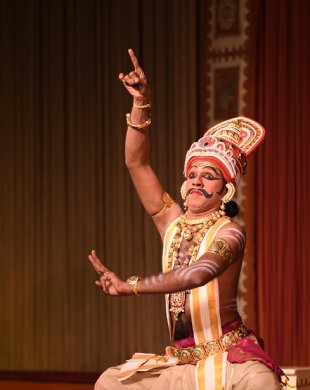 I did see Sita Swayamvaram in other cities when we had six days Ramayana Festival at Shanmukhananda Hall in Mumbai for fund raising. Later on in Bangalore, Kolkata, New Delhi. Each time the spell continued. Now in 2018 during the 65th Annual Arts Festival of Kalakshetra Foundation, Sita Swayamvaram was the opening dance drama. By fortuitous circumstances it was 20th December, my birthday. I could not have received a better gift than watching this wonderful creation of Rukmini Devi. Rukmini Arangham has been renovated with pucca roof, tiles, seating arrangements and lighting and before the performance, the mosquito repellant smoke fills up the auditorium. The musicians sit in the right hand corner of the stage. The decoration of the coconut leaves creates an exquisite ambience. You are in a tapovana; outside the auditorium beautiful kolam designs are drawn on the ground. The collages of photo exhibition, which I was lucky to curate for centenary celebrations of Rukmini Devi, are displayed on the right side when one enters. And from there further in the gallery one sees works of art students and Lakshmi Krishnamurty. The one Tanjore painting of Saraswati sitting on a lotus, with real jewels and gold plates is fascinating. The Kalakshetra crafts and weaving departments display the sarees and objects which invariably draws one's attention. The music of nadaswaram fills the air with Hamsadhwani raga and the atmosphere prepares one for the unfolding of the Rama story. For the past few years, arrangements have been made to project subtitles in English on either side and are clearly visible and readable. I am told it was done during the time of Leela Samson's tenure as director. Priyadarsini Govind continued the practice. It has been such a joy to listen to the Sanskrit rendering of the slokas. Though I know Sanskrit and have studied the classics, I must confess I have not read original Ramayana by Valmiki in Sanskrit. Therefore the selection of verses by Periya Sarada, the musicians and Rukmini Devi continues to elicit admiration as it keeps one engaged in the flow of the story, scene by scene and with excellent dancing by all members of the dance drama. Each young female dancer in the role of sakhis, maids at the royal court, with uniform physical frame, slim and like ballerinas we see in a Western ballet, perform with precision, concluding teermanams with flawless finish. Attired in exquisite costumes with eye catching colours, they create beautiful visuals. I knew late Maragatham who was in charge of costumes. She was trained under the watchful eyes of Rukmini Devi and hence the colour patterns were always a delight to behold. When you are in Kalakshetra with its beautiful stage, with frames of material for the royal court, magenta, browns of different shades and the light playing chiaroscuro, the complete impression is overwhelming. It indeed is an artistic experience to watch dance dramas of Rukmini Devi in this theatre, and in particular Ramayana. The scene opens with two maids checking that the asanas, seats for rishis, the royal simhasana with colourful umbrellas for the king, the main entrance and two side windows are all properly set. With melodious singing by Sai Shankar and Hariprasad, the auspicious shloka in praise of Rama is chanted, and from the side door enters King Dasaratha, seated on his right is Vashishta rishi and royal maids welcome the king. They dance in joy, the singing narrates that since the king did not have any children, putrakameshti yagna was performed whereby Kaushalya got Rama, effulgent like thousand suns, Kaikeyi got Bharata and Sumitra got Lakshmana and Shatrughna. Rishi Vishwamitra (played by veteran artiste Janardhanan) arrives and is received with all traditional rituals. His entry was greeted with thunderous applause. The senior most disciple of Rukmini Devi, now in his eighties, he performs with great dignity and gets under the skin of the character he plays. 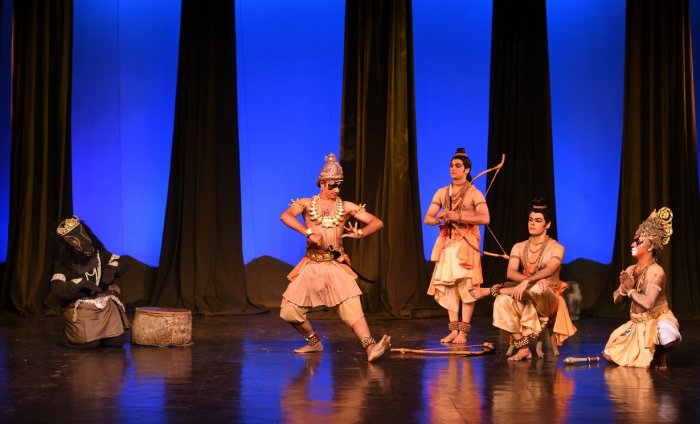 Dasaratha promises him whatever he would ask for as per the Raghuvamsha riti. Vishwamitra asks that Rama and Lakshmana accompany him to protect the yagna he is performing in the forest where the rakshasas are destroying yagna vedi. Only Rama and Lakshmana could kill these rakshasas. Dasaratha is heartbroken; he tries to tell the rishi they are too young, in their place he volunteers to go, but Vishwamitra gets angry and taunts him for going back on his word, which is against the tradition of Raghukula. He picks up his kamandalam and stick and starts to leave, but rishi Vashishta pacifies him and assures Dasaratha that Rama and Lakshmana will be safe with Vishwamitra and he need not worry. In the next scene with backdrop of trees we see Vishwamitra in his ashram performing yagna, Rama and Lakshmana keeping watch with bow and arrow. For six days and nights without a wink both guard the ashram, kill the rakshasas and Vishwamitra completes the yagna. He comes out of the cottage and embraces Rama, then asks where Lakshmana is. Vishwamitra signals Rama to stay quiet and gently touches Lakshmana who turns in anger raising his bow and arrow to kill; Vishwamitra explains to him that he wanted to just frighten him a little. This little episode replete with hasya rasa was enacted by Janardhanan beautifully. They proceed northwards to Mithila nagari of king Janaka. On the way, the rishi shows the young princes the forest. The description of the forest, as in Kathakali, is enacted by Janardhanan, showing elephants uprooting trees in their way, tall insurmountable mountains, the banks of river where chakravaka and sarasa birds are playing, the lotuses and the swimming fish. So graphic is the abhinaya that the rich forest comes alive. On the way they see an empty ashram and a cottage. Vishwamitra tells them that the occupants are invisible. He tells them the story of rishi Gautama cursing Indra and turning Ahalya into a stone, that she would come back to life when Lord Rama passes through the forest. When Rama touches the stone, lo and behold, it turns into beautiful Ahalya who offers prayers to three of them. The miracle of invisible stone turning into Ahalya is artistically depicted. For a moment it is pitch dark and then light falls on a crouched figure that gets up as a woman and touches feet of Rama. It is one of the finest choreographic touches by Rukmini Devi. When Vishwamitra, Rama and Lakshmana arrive in the court of Janaka where swayamvara is to be held, we see other kings bragging about their prowess to lift the bow of Lord Shiva. Towering above all of them Ravana sits quietly. Sita with her maids watches from the window and is mesmerized seeing handsome Rama. I have already mentioned the exquisite poetry of Valmiki when Sita prays to Lord Shiva to make the bow lighter than the flower, as Rama looks delicate like a flower. She prays and it is rendered like a soliloquy. The other characters remain frozen like in a painting, not even blinking an eye. Rukmini Devi's genius in choreographing this sequence as Sita's soliloquy remains etched in one's memory. 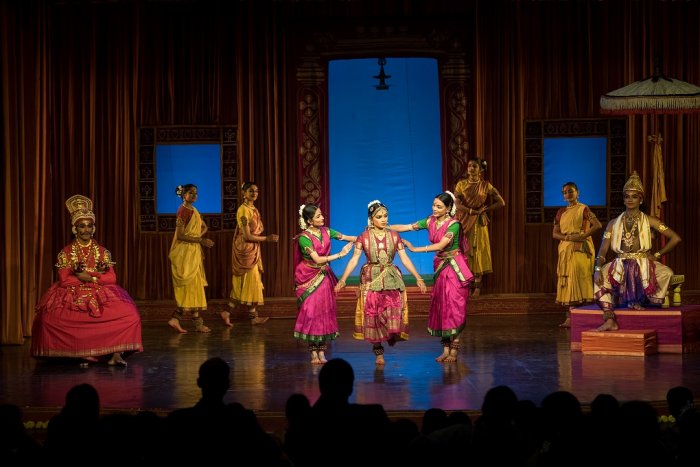 The lifting of the bow by various kings is replete with humour, as they flex their muscles only to fall flat on the floor. Haripadman as a king shivering steals the show with his perhaps on the spot improvisation. Mighty Ravana attempts and almost succeeds in lifting the bow, but alas it falls on him and he faints. Vishwamitra asks Rama to lift the bow from Ravana's body. Ravana on regaining consciousness gets up in anger and leaves the court in a huff. Rama lifts the bow dancing in all four directions. Sita is asked to come forward and garland Rama. All are agog with joy and music fills the air. The gods and goddesses, gandharvas and kinnaras shower flowers on the divine couple. Though I have seen this production earlier, I had not noticed that when Rama lifts the bow successfully, there follows a tillana and then Sita is called to garland Rama. That sounded incongruous, because to suggest victory of Rama with a tillana breaks the momentum of success. The swayamvara with all the pomp, Rama and Sita's marriage being conducted, finally seated on the throne with royal umbrella over it, the courtiers and Vishwamitra, King Janaka and maids, all fill up the stage. The flowers are showered from heaven. One felt elated watching this spectacle. The auspicious shlokas were recited and the dance drama ended lifting audience to a spiritual level. The new generation of young dancers who played the various roles are - Rama: Srinath, Lakshmana: Amalanathan, Dasaratha: Girish, Vashishta: Haripadman, Janaka: Raakesh, Sita: Janet, Ravana: Jayakrishnan, Vishwamitra: Janardhanan. The music ensemble - vocal: Sai Shankar and Hariprasad, nattuvangam: K.P. Raakesh, mridangam: Anilkumar, veena: Ananthanarayanan, flute: T. Sashidharan, violin: Sivakumar, lighting: Venkatesh Murgan. The core team remains more or less but they carry the entire production with professional approach in a flawless manner. They are the new faces in the Ramayana series. Mahapattabhishekam The final in the series was Mahapattabhishekam on the last day of the festival, when the auditorium was overflowing with rasikas who had come well in advance. There was an atmosphere of joy, signs of auspiciousness. Every time Mahapattabhishekam is staged, special prasad is distributed to the audience at the end of the dance drama. The vision of Rukmini Devi to create that blissful atmosphere continues with successive presentations and by the directors. On the right of the stage were two purohits reciting Veda mantras before the dance drama began. Then entered Vibhishana offering prayers to Shiva linga. In this serene atmosphere after offering prayers Vibhishana sends request to see Rama. Being a brother of enemy Ravana, Lakshmana and Hanuman get agitated but Rama reassures them that he is his devotee and must be accorded proper respect and welcome. Rama's and Vibhishana's meeting is very emotional. The story unfolds with familiar episodes. The most surprising choreographic ploy Rukmini Devi has employed was of description of the war by apsaras who watch from heaven, the battle between the army of Ravana and the monkeys accompanying Rama. The apsaras with their colorful scarves standing on top of four stones, as it were from heaven, watch and describe the important chieftains being killed. The arrow hits Lakshmana and he becomes unconscious. Rama is aghast and Hanuman is sent to bring from a mountain the medicinal plant which would help Lakshmana recover. Hanuman flies and brings the whole hillock as he could not locate what the plant could be. The entire episode is imaginatively choreographed and the audience applauds spontaneously. Such involvement on part of audience is a tribute to Rukmini Devi's presentation with exquisite music composed by Rajaram. 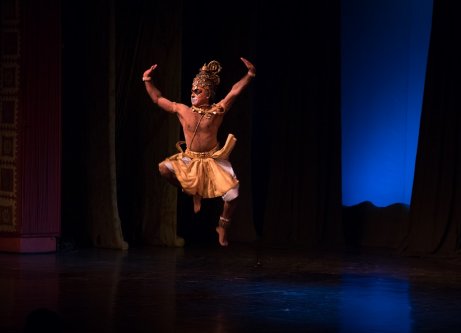
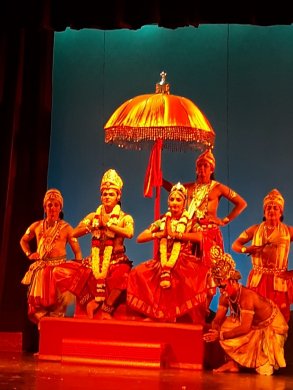 The fight between Rama and Ravana, sage Vishwamitra reciting the mantra in Rama's ears to shoot arrow at Ravana, ends in Ravana's death. Mandodari weeps and begs of Rama to forgive Ravana. When Sita is brought before Rama, the heart wrenching scene starts. He turns away from Sita and demands of her to undergo the agni pariksha to prove her chastity, having been kept captive by Ravana. Lakshmana is extremely pained and so is Hanuman. Helpless Sita's agony moves us all. I remember when Rukmini Devi was choreographing this sequence, she was extremely unhappy and could not reconcile to Rama's demand. Even today, the interpretation of Rama's demand causes confusion. What is the nature of such Rajyadharma? Why had Rama to follow the dictate of people who would expect the king to have his wife undergo such examination of chastity? Finally, after agni pariksha all go to Ayodhya. On the way Bharata receives Rama, placing Rama's footwear before him and takes his blessings. The Mahapattabhishekam scene is spectacular. Dressed in royal clothes, with ornaments, with sage Vashishta conducting rituals, with waters of five rivers, asking Sita to offer the pearl necklace to Hanuman for his devotion, and final crowning of Rama, the entire scene remains etched in memory even after so many years. The gods shower flowers from the heaven. The exquisite colours, choreography, the music et al are of such high aesthetics that one is transported to a state of bliss. I have always felt a sense of inner peace watching Mahapattabhishekam. The audience gave a rousing ovation when the mangal shlokas were recited. An army of people had contributed to the production. Revathi Ramachandran, the director, had an excellent team to ensure smooth running of the festival. Ramayana dance dramas are a gift of highest artistic order from Rukmini Devi and the magic that the stage and atmosphere creates at Rukmini Arangham is very special and worth experiencing. The young dancers who have taken over from the seniors are performing with excellent nritta and abhinaya. In Mahapattabhishekam the roles were played by the following dancers. Rama: Girish, Lakshmana: Srinath, Sita: Sridevi, Ravana: Jayakrishnan, Vibhishana: Suryanarayanamurthy, Vashishta: Jayakrishnan. The music as usual by the lead musicians as mentioned in Sita Swayamvaram, with change in nattuvangam: Jyolsna Menon and K.P. Raakesh.  Dr. Sunil Kothari is a dance historian, scholar, author and critic, Padma Shri awardee and fellow, Sangeet Natak Akademi. Dance Critics' Association, New York, has honoured him with Lifetime Achievement award. Post your comments Please provide your name and email id when you use the Anonymous profile in the blog to post a comment. All appropriate comments posted with name & email id in the blog will also be featured in the site. |